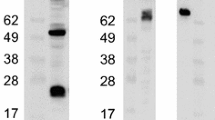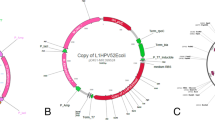Summary
We have used a bovine papilloma virus (BPV) based mammalian cell expression vector consisting of the complete BPV genome and a human cytomegalovirus transcription unit for the production of soluble CD4. Mouse C-127 cells were transfected with vector DNA together with a selectable G418 resistance plasmid. Surviving clones were selected for high production using a solid phase ELISA based on the immobilization of supernatant-derived CD4 onto nitrocellulose paper and subsequent detection with anti-CD4 antibodies. The expressed protein was shown to bind HIV-gp120 and efficiently block HIV-1 infection in vitro. The possibility to use the above system for rapid production of defined glycoprotein fragments harboring defined functional regions, for the further elucidation of the functional role of CD4 in antigen presentation and cell to cell contact, and for possible intervention during HIV infection is discussed.
Similar content being viewed by others
References
Maddon PJ, Littman DR, Godfrey M, Maddon DE, Chess L, Axel R (1985) The isolation and nucleotide sequence of cDNA encodig the T cell surface protein T4: a new member of the immunoglobulin gene family. Cell 42: 93–104
Clason JB, Tsagaratos J McKenzie J, Walker ID (1986) Partial primary structure of the T4 antigens of mouse and sheep: assignment of intrachain disulfide bonds. Proc Natl Acad Sci USA 83: 4499–4503
Gay D, Maddon P, Sekaly R, Talle M, Godfrey M, Long E, Goldstein G, Chess L, Axel R, Kappler J, Marrack P (1987) Functional interaction between human T-cell protein CD4 and the major histocompatibility complex HLA-Dr antigen. Nature 328: 626–626
Saizawa K, Rojo J, Janeway Jr CA (1987) Evidence for a physical association of CD4 and the CD3:alfa:beta T-cell receptor. Nature 328: 260–263
Laskey L, Nakamura G, Smith D, Fennie C, Shimasaki C, Patzer E, Berman P, Gregory T, Capon D (1987) Delineation of the human immunodeficiency virus type 1 gp120 glycoprotein critical for interaction with the CD4 receptor. Cell 50: 975–985
Åsjö B, Ivhed I, Gidlund M, Fuerstenberg S, Fenöy EM, Nilsson K, Wigzell H (1987) Susceptibility by the human immunodeficiency virus (HIV) correlates with T4 expression in a parental monocytoid cell line and its subclones. Virology 157: 359–365
Deen K, McDougal S, Inacker R, Folena-Wasserman G, Arthos J, Rosenberg J, Maddon P, Axel R, Sweet R (1988) A soluble form of CD4 (T4) protein inhibits AIDS virus infection. Nature 331: 82–84
Traunecker A, Luke W, Karjalainen K (1988) Soluble CD4 molecules neutralize human immunodeficiency virus type I. Nature 331: 84–86
Landau N, Warton M, Littman D (1988) The envelope glycoprotein of the human immunodeficiency virus bind to the immunoglobulin-like domain of CD4. Nature 334: 159–162
Smith D, Byrn R, Marsters S, Gregory T, Groopman J, Capon D (1987) Blocking of HIV-1 infectivity by a soluble, secreted form of the CD4 antigen. Science 238: 1704–1707
Jameson B, Rao P, Kong L, Hahn B, Shaw G, Hood L, Kent S (1988) Location and the chemical synthesis of a binding site HIV-1 on the CD4 protein. Science 240: 1335–1339
Matthews T, Weinhold K, Lyerly K, Langlois A, Wigzell H, Bolognesi D (1987) Interaction between the human T-cell lymphotropic virus type IIIB and the surface antigen CD4: Role of carbohydrate in binding and cell fusion. Proc Natl Acad Sci USA 84: 5424–5428
Nygren A, Bergman T, Matthews T, Jörnvall H, Wigzell H (1988) 95- and 25-kDa fragments of the human immunodeficiency virus envelope glycoprotein gp120 bind to the CD4 receptor. Proc Natl Acad Sci USA 85: 6543–6546
Sarver N, Byrne J, Howley P (1982) Transformation and replication in mouse cells of a bovine papillomavirus-pML2 plasmid vector that can be rescued in bacteria. Proc Natl Acad Sci USA 79: 7147–7151
Sanger F, Nicklen S, Coulson A (1977) DNA sequencing with chain-terminating inhibitors. Proc Natl Acad Sci USA 74: 5463–5467
Boshart M, Weber F, Jahn G, Dorsch-Häsler K, Fleckenstein B, Schaffner W (1985) A very strong promotor is located upstream of an immediate early gene of human cytomegalovirus. Cell 41: 521–530
Sothern B, Berg P (1982) Transformation of mammalian cells to antibiotic resistance with a bacterial gene under control of the SV40 early region promoter. J Mol Appl Gen 1: 327–331
Jahn R, Schiebler W, Greengard P (1984) A quantitative dot-immunobinding assay for protein using nitrocellulose membrane filters. Proc Natl Acad Sci USA 81: 1684–1687
Lundin K, Nygren A, Arthur L, Robey W, Morein B, Ramstedt U, Gidlund M, Wigzell H (1987) A specific assay measuring binding of125I-gp120 from HIV+ to T4/CD4 cell. J Immunol Methods 97: 93–100
Harada S, Koyanagi Y, Yamamoto N (1985) Infection of HTLV-III/LAV in HTLV-I-carrying cells MT-2 and MT-4 and application in a plaque assay. Science 229: 563–566
Sundqvist V, Albert J, Ohlsson E, Hinkula J, Fenöy EM, Wahren B (1989) HIV-1 p24 antigen variation in tissue culture of isolates with defined growth characteristics. J Med Microbiol 29: 170–175
Hemming A, Bolmstedt A, Flodby P, Lundberg L, Gidlund M, Wigzell H, Olofsson S (1990) Cystein 402 of HIV gp120 is essential for CD4 binding and resistance of gp120 to intracellular degradation. Arch Virol 109: 269–276
Doyle C, Strominger J (1987) Interaction between CD4 and class II MHC molecules mediates cell adhesion. Nature 330: 256–259
Sattentau Q, Dalgleish A, Weiss R, Beverly P (1988) Epitopes of the CD4 antigen and HIV infection. Science 234: 1120–1124
Author information
Authors and Affiliations
Rights and permissions
About this article
Cite this article
Gidlund, M., Sydow, M., Stenbeck, A. et al. Production and characterization of a fragment containing the HIV-gp120 binding region of CD4 using a bovine papilloma virus (BPV) vector. Archives of Virology 113, 209–219 (1990). https://doi.org/10.1007/BF01316674
Received:
Accepted:
Issue Date:
DOI: https://doi.org/10.1007/BF01316674




